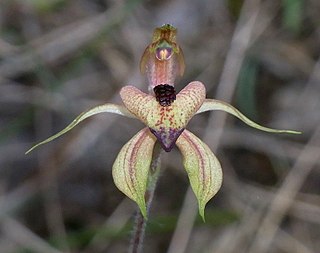Caladenia abbreviata, commonly known as the coastal spider orchid, is a plant in the orchid family Orchidaceae and is endemic to the south-west of Western Australia. It has a single erect, hairy leaf and up to three pale, creamy-yellow flowers on a flowering stem up to 35 cm (10 in) high. Although the flowers have long, thread-like petals and sepals, they are shorter and darker than those of other spider orchids. It is a rare, relatively recently discovered species although often found near human activities.
Caladenia ambusta, commonly known as the Boranup spider orchid, is a plant in the orchid family Orchidaceae and is endemic to the south-west of Western Australia. It has a single erect, linear leaf and a single creamy-coloured flower on a stem 27–35 cm (11–14 in) high. It is only known from a relatively small area south-west of Margaret River growing in deep sand in shrubland and woodland and only flowering profusely after fire.

Caladenia ampla, commonly known as the dainty spider orchid, is a plant in the orchid family Orchidaceae and is endemic to Victoria. It is a ground orchid with a single hairy leaf and a single flower which is sometimes yellowish-green flower with red stripes and sometimes entirely red.
Caladenia ancylosa, commonly known as the Genoa spider orchid, is a plant in the orchid family Orchidaceae and is endemic to Victoria. It is a ground orchid with a single hairy leaf and a single cream-coloured flower with red markings.

Caladenia australis, commonly known as southern spider orchid, is a plant in the orchid family Orchidaceae and is endemic to Victoria, although it was also found on one Bass Strait island on one occasion in 1968. It has a single hairy leaf and usually only one creamy-yellow flower with red streaks, the flower on a hairy stalk.

Caladenia capillata, commonly known as white daddy long legs or wispy spider orchid, is a plant in the orchid family Orchidaceae and is endemic to Victoria and South Australia. It is a ground orchid with a single hairy leaf and up to three cream-coloured to yellowish flowers with long, thread-like petals and sepals and a very small labellum.

Caladenia cardiochila, commonly known as thick-lipped spider-orchid, fleshy-lipped caladenia and heartlip spider-orchid, is a plant in the orchid family Orchidaceae and is endemic to Victoria and South Australia. It is a ground orchid with a single hairy leaf and one or two yellowish-green, red-striped flowers on a thin, wiry stem.

Caladenia clavescens is a plant in the orchid family Orchidaceae and is endemic to central Victoria in Australia. It is a ground orchid with a single hairy leaf and usually a single dark red to maroon flower.
Caladenia conferta, commonly known as the crowded spider orchid or coast spider-orchid, is a plant in the orchid family Orchidaceae and is endemic to a restricted area in South Australia. It is a ground orchid with a single hairy leaf, and usually a single yellowish-green flower with red markings on a wiry, hairy stalk.
Caladenia cretacea, commonly known as Stuart Mill spider orchid, is a plant in the orchid family Orchidaceae and is endemic to a small area in Victoria. It is a rare ground orchid with a single leaf and one or two white flowers on a hairy stalk.

Caladenia cucullata, commonly known as the hooded caladenia, is a plant in the orchid family Orchidaceae and is endemic to south-eastern Australia. It is a ground orchid with a single, sparsely hairy leaf, and up to seven white flowers with a purplish labellum.
Caladenia denticulata subsp. albicans, commonly known as the alabaster spider orchid, is a plant in the orchid family Orchidaceae and is endemic to the south-west of Western Australia. It has a single erect, hairy leaf and one or two pale creamy-white flowers which have a white labellum with red markings. The only known population occurs in a small area near Arrowsmith.
Caladenia erythronema, commonly known as the red thread spider orchid, and Nyabing spider orchid is a plant in the orchid family Orchidaceae and is endemic to the south-west of Western Australia. It has a single hairy leaf and up to three red, yellow or cream-coloured flowers with dangling, thread-like sepals and petals and a small labellum.
Caladenia flaccida, commonly known as the flaccid spider orchid, is a plant in the orchid family Orchidaceae and is endemic to eastern Australia. It is a ground orchid with a single hairy leaf and up to three cream-coloured, pinkish or red flowers with long, thread-like, glandular tips on the sepals and petals.

Caladenia formosa, commonly known as the large crimson spider orchid, or elegant spider orchid is a plant in the orchid family Orchidaceae and is endemic to Victoria and South Australia. It is a ground orchid with a single hairy leaf and a single crimson-coloured flower and which mainly occurs only in south-western Victoria.
Caladenia hastata, commonly known as Mellblom's spider orchid is a plant in the orchid family Orchidaceae and is endemic to Victoria. It is a ground orchid with a single hairy leaf and up to three white to cream-coloured flowers with red markings on the labellum.
Caladenia osmera is a plant in the orchid family Orchidaceae and is endemic to south-eastern Australia. It is a ground orchid with a single leaf and one or two greenish-cream flowers with pink stripes and which has a sharp odour resembling burnt plastic.
Caladenia patersonii is a plant in the orchid family Orchidaceae and is native to Victoria and Tasmania. It is a ground orchid with a single hairy leaf and one or two creamy-white, yellowish or pink flowers.
Caladenia branwhitei, commonly known as the Bethungra spider orchid, is a plant in the orchid family Orchidaceae and is endemic to southern New South Wales. It has a single dull green leaf and one or two, usually dark red to maroon-coloured flowers. It is only known from three areas near Bethungra where it grows in ironbark forest.
Caladenia flindersica is a plant in the orchid family Orchidaceae and is endemic to South Australia. It is a ground orchid with a single leaf and one or two cream-coloured flowers with thin dark red to blackish tips on the petals and sepals. It is only known from Alligator Gorge in the Mount Remarkable National Park.






















